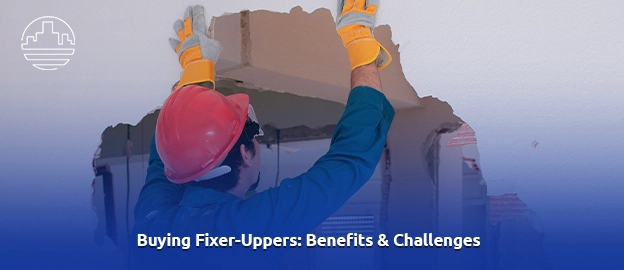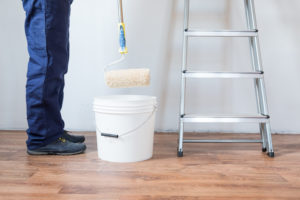
Fixer-upper investment properties have become very popular in recent years due to the “fixer-upper” television show. Thus, this real estate strategy is sought-after for good reasons. Although fixer-uppers have many risks, they can also be very rewarding if done the right way. Flipped properties can be a great way for first-time investors to enter the business within their own budget. They can also allow investors to be creative and personalize the property the way they want it. This guide will discuss the many dos and don’ts, as well as various factors to consider when investing in a fixer-upper property.

What is a Fixer Upper?
If you’ve seen the HGTV show “Fixer Upper,” you might be familiar with the concept. A Fixer Upper is an older home, often lacking modern updates or safety features, that requires significant repairs and renovations to be fully livable.
These homes are often priced lower due to the needed repairs, giving you the chance to get a great deal. By addressing repairs promptly, you can prevent costs from rising and ensure that your bargain remains a smart investment.
Buying a fixer-upper isn’t for everyone. Many buyers dream of transforming a house in their ideal neighborhood to match their vision, but these projects often come with financial and logistical challenges. That said, with careful planning, the rewards can be well worth the effort.
Essential Tips for Buying a Fixer-Upper House
If you’re considering buying a fixer-upper, here are some tips to consider:
1. Schedule a Home Inspection
Even though a home inspection costs a few hundred dollars, it’s a crucial step when buying a fixer-upper. A qualified inspector should thoroughly examine the property and give you a detailed report on any repairs needed.
By getting a home inspection, you stay informed about potential issues like faulty plumbing, a failing septic tank, or a cracked foundation. This proactive approach helps you avoid surprises and lets you plan and budget for necessary repairs effectively.
2. Estimate Renovation Costs
When you buy a fixer-upper, you need to ensure that you can comfortably fund the renovations needed to transform it into your dream home. Begin by listing all the projects you plan to tackle and researching the costs for materials and labor (especially if you hire a contractor).
You can conduct online research and gather quotes from contractors to get a clearer picture of what to expect. Although you may not calculate exact costs, estimating a rough budget will help you determine if the investment is worthwhile.
3. Check if You Need a Permit
Before you start your renovations, you must check if you need a permit. The requirements vary by location, but most towns and cities usually require permits for:
- Structural changes
- Installing windows
- Adding rooms
- Building sheds or garages
- Erecting fences
- Plumbing and electrical work
You can apply for a permit online or in person at your local government office. If your project is complex, be ready to submit detailed plans.
4. Determine What You Can Renovate on Your Own
DIY renovations can save you a lot of money since hiring contractors for every project can be costly. If you’re skilled with tools or have friends and family who are, consider taking on the tasks you can handle yourself.
Even if electrical or plumbing work isn’t within your skill set, you can still tackle painting or installing a backsplash on your own.
5. Consider Fixer-Upper Loan Options
When buying a home that needs renovations, you can take advantage of loans designed specifically for this purpose. These loans can cover both the purchase price and renovation costs.
For instance, with an FHA 203(k) rehabilitation loan or a Fannie Mae HomeStyle Renovation Mortgage, you can buy your new home and allocate funds in escrow for the needed improvements.
6. Make a Smart Offer
You can aim to avoid overpaying for a fixer-upper by making a well-balanced offer. The key is to get a great deal while accounting for the cost of necessary repairs.
Try including contingencies in your offer. These are conditions that let you withdraw if issues arise. Common contingencies include inspection and appraisal. If an inspection reveals a major problem or the home appraises are lower than your offer, you can walk away.
You can negotiate the selling price to your advantage. If the home has noticeable flaws, you may have more leverage in the negotiation. Work closely with your agent to create a strategic offer and handle any counteroffers. If the seller isn’t open to negotiation, feel confident about walking away from the deal.
Pros and Cons of Buying a Fixer-Upper
Here are some pros and cons of fixer-upper houses to consider:
Pros
- Lower Purchase Price: Fixer-uppers usually come with a lower list price and down payment requirement, allowing you to save on the initial cost despite spending more on renovations.
- Less Competition: You’ll probably face less competition for fixer-upper homes, increasing your chances of securing the property you want at a favorable price.
- Customization Opportunities: Buying a fixer-upper can give you the freedom to tailor the home to your preferences. If you wish to remodel the kitchen, add a deck, or expand the living room, you can make those changes.
- Quality Control: With renovations, you can have control over every detail. Choose your materials, colors, and contractors to create your dream home exactly the way you envision it.
Cons
- Expensive Renovations: Depending on the scope of your renovations, you might find yourself spending more than you anticipated—or barely breaking even on your fixer-upper.
- Budgeting Challenges: Although you can estimate renovation costs, achieving an exact figure is nearly impossible. Unexpected expenses are likely to arise.
- Unexpected Issues: Even with a thorough inspection, older homes often reveal surprises that need addressing.
- Ongoing Construction: If you stay in your home during renovations, you’ll live in a construction zone until the project is complete.

Dos and Don’ts of a Fixer-Upper
- Do acknowledge all of the finances. Not overpaying for a fixer-upper property should be the top priority for any investor’s finances. Then come in the repairs and renovations that the property will need. A fixer-upper can become pricey quickly and might require additional financing from a third party such as a credit card, conventional financing, or FHA 203k loan. The 203k loan was developed by the Federal Housing Administration to specifically encourage renovating older homes.
- Do choose a good location. A fixer-upper property’s location is just as important as the other qualities one might look for. If the general location isn’t a good area, it could make for a poor investment. Some factors to consider when choosing a location include accessibility to surrounding areas, school districts, and local amenities. Another thing to consider is avoiding a property with other fixer-upper homes surrounding it. Tenants don’t want to live in an area with abandoned, boarded-up homes. Although it might present itself as a promising market, a neighborhood like this won’t make for the best investment.
- Don’t disregard foundational or layout issues. Many fixer-uppers might appear a better deal than they actually are. Be sure to understand all of the possible repairs, including if the property has any issues with the foundation. Any major cracks or shifts in the foundation can turn any low-risk investment into a high-risk one. A fixer-upper with a bad layout can also be the cause for complete reconstruction and major financing. A good layout should be practical and allow space to flow. Hiring an experienced home inspector will ensure that there are no surprises before investing in a fixer-upper property.
- Don’t underestimate repair costs. Most fixer-upper properties will include cost estimates for the repairs, but they aren’t necessarily accurate. Inspection reports can be off and many repairs can turn into even bigger ones. It’s important to be completely aware of the repair costs, including any additional repairs that might come up. It’s also good to know the easy fixes versus what repairs will cost more time and money. Easy fixes can include replacing doors or adding ceiling fans while more expensive fixes can include replacing plumbing or pouring concrete.
Some other factors to consider when investing in a fixer-upper property include:
- Finding a good contractor
- Calculating the best ROI
- Whether to DIY or hire professionals
- Negotiating with a forceful seller
- An “as-is” contract
Conclusion
At first glance, a fixer-upper can appear to be an irresistible bargain. However, once you dive into the potential costs of repairs and renovations, your perspective might change. To ensure you are making a smart investment, take your time to thoroughly assess the property before making an offer. Conduct a detailed home inspection and estimate the costs of necessary improvements. By doing this groundwork, you can confidently determine whether the fixer-upper is truly a worthwhile investment or if it’s better to look for other opportunities. This proactive approach will help you make an informed decision and avoid unexpected expenses.
For further inquiries, you can reach out to us at BFPMInc.
Learn more about how we can help. Customized solutions for large portfolios!
